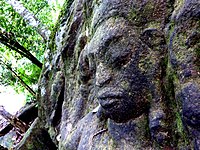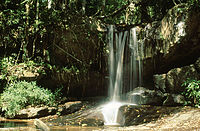Kbal Spean
| Kbal Spean | |
|---|---|
ក្បាលស្ពាន | |
King Suryavarman I and King Udayadityavarman II[1] | |
| Completed | 11th to 12th centuries[1] |
| Monument(s) | One |
Kbal Spean (
The site consists of a series of stone
Geography
Kbal Spean is described as "a spectacularly carved riverbed, set deep in the jungle to the northeast of Angkor".[4] The river over which the bridge head exists is also known as Stung Kbal Spean, a tributary of the Siem Reap River that rises in the Kulein mountains north of Banteay Srei. The river bed cuts through sandstone formations, and the many architectural sculptures of Hindu mythology have been carved within the sandstone. The archaeological site occurs in a stretch of the river starting from 150 metres (490 ft) upstream north of the bridge head to the falls downstream.[1] The river, being sanctified by flowing over the religious sculptures, flows downstream, bifurcating into the Siem Reap River and Puok River, which eventually flows into the Tonlé Sap Lake after passing through the plains and the Angkor temple complex.[1][2][3]
The archaeological site is in the western part of the Kulein mountains[1][7] within the Phnom Kulen National Park. Approach is from the Banteay Srei temple by a road which is about 5 kilometres (3.1 mi) from an army camp. Thereafter, it is a 40-minute walk through the forest for about 2 kilometres (1.2 mi) uphill along a path before reaching the first site, a water fall, where the carved sculptures start appearing in the river bed.
History
The carving of vestiges began with the reign of
The archaeological site was discovered in 1969 by Jean Boulbet, an ethnologist, but further exploration was cut off due to the Cambodian Civil War. The site regained prominence for safe visits from 1989.[6]
Layout
The bridge is a natural sandstone arch 50 kilometres (31 mi) northeast of Siem Reap River. Just after the monsoon season, when the water level in the river starts dropping, the carvings are visible in a 150 metres (490 ft) stretch upstream of the bridge and from the bridge downstream up to the falls.[1][5] The 11th century carvings in this stretch of the river are a galaxy of gods, the trinity of Brahma, Vishnu and Shiva or Maheswara and celestial beings; several carvings of Vishnu with Lakshmi reclining on the serpent Ananta, Shiva with consort Uma, known as Umamaheswar Brahma on a lotus petal over a plant stem rising from the navel of Vishnu, Rama and Hanuman are the sculptures seen not only in the river bed but also on the river banks.
Sequentially, while walking along a path which skirts the eroded channel of the river-formed natural stone bridge, one can see a pair of Vishnu sculptures with Lakshmi seated at his feet in a reclining pose. Upstream of the bridge, there is a sculpture of Shiva and Uma mounted on the bull. Approximately 30 metres (98 ft) downstream of the bridge, there are additional Vishnu sculptures. Further downstream up to the water fall and till the water pool are the Sahasra lingas in
After the carvings, the river falls by 15 centimetres (5.9 in) to a clear water pool. As it flows over the holy lingams, the river attains a sanctified status and passes through the temples that are downstream.
Sculptures
The sculptures carved in the river bed and banks depict many Hindu mythological scenes and symbols. There are also inscriptions which get exposed as the water level in the river decreases. The common theme of these sculptures emphasizes creation as defined in Hindu mythology in the form of Lord Vishnu lying on a serpent in a reclining repose on the ocean of milk in meditation, the lotus flower emerging from Vishnu’s navel which bears god Brahma, the creator. Following these sculptures seen carved on the banks of the river, the river flows through several sculpted reliefs of Shiva the destroyer shown in the universal symbol of the Linga; 1000 such lingas have been carved in the bed of the river which gives the name to the river valley formed by the river as "valley of 1000 lingas".[1][2][7] Vishnu is also carved to match the contours of the river bed and banks. A carving of Shiva with his consort Uma is also visible.
Though the sculptures have been vandalized and damaged, the carved idols still retain their original grandeur.
Biodiversity
Also situated within the Phnom Kulen National Park,[9] and close to the river outfall, is the Angkor Centre for Conservation of Biodiversity where "trafficked animals are nursed back to health".[10]
Gallery
-
Brahma in the river bed
-
Lingas under water
-
Lotuses
-
Vishnu and Lakshmi
References
- ^ )
- ^ a b c d Tye, Timothy. "UNESCO World Heritage Site: Kbal Spean -Carved riverbed of ancient Angkor". asiaexplorers. Archived from the original on 7 July 2011. Retrieved 20 May 2011.
- ^ a b c "Kbal Spean". Authority for the Protection and Management of Angkor and the Region of Siem Reap (APSARA). Archived from the original on 27 May 2012. Retrieved 20 May 2011.
- ^ ISBN 978-1-74179-426-7.
- ^ ISBN 978-1-906098-15-5. Retrieved 20 May 2011.
- ^ a b Ray, Nick; Bloom, Greg; Robinson, Daniel (26 August 1967). Cambodia. Lonely Planet. pp. 190–. GGKEY:ALKFLS6LY8Y. Retrieved 20 May 2011.
- ^ ISBN 978-1-85828-837-6. Retrieved 20 May 2011.
- ISBN 978-1-4262-0520-0. Retrieved 22 May 2011.
- ^ Kist, Fleur (18 February 2010). "Vacancies: Volunteer Keeper". European Association of Zoos and Aquaria. Archived from the original on 20 July 2011. Retrieved 22 May 2011.
- ISBN 978-1-74179-174-7.
External links
- Photos of Kbal Spean
- ngoforum.org.kh Current situation of the Kbal Spean community







